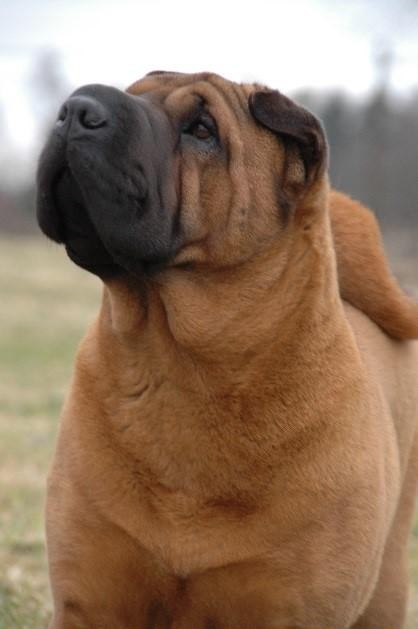The wrinkles must be reduced – statement from the SKK regarding breeding of
Shar Pei dogs
The Shar Pei breed is characterized by its distinctive features of thickened skin and heavy wrinkles. The underlying accumulation of hyaluronic acid, resulting in a feature named hyaluronosis, may if exaggerated lead to several heath issues, for example eye injuries caused by the eyelashes curling inwards irritating the eye.

A “moderate” western type of Shar Pei. (Photo: Anna Thorsjö)
At a recent meeting with the SKK Breeding Committee on January 24th a statement regarding breeding of Shar Pei dogs was made, in order to clarify SKK’s view on necessary priorities in selection aiming at a reduced risk of eye conditions or other health issues related to the thickened skin. Hence, the following statement was made:
Dogs exhibiting health problems, i.e. illness or disabilities, may not be bred. In the Shar Pei breed, this implies that dogs exhibiting clinical signs of the disease SPAID (Shar Pei Autoinflammatory Disorder) or eye injury caused by thickened skin/heavy wrinkles may not be used for breeding.
Moreover, because the health issues prevalent in this breed are closely linked to the thickened skin, priority in breeding must be to reduce the number of dogs born exhibiting an exaggerated phenotype. In practice this means that dogs with heavily thickened skin/excessive amount of wrinkles should be excluded from breeding. Instead, dogs with less thickened skin should be rewarded and used in breeding more than hitherto.
 Phenotypic spectrum of the Shar Pei. Western (meatmouth) type (A–C) and traditional type of Shar Pei (D). Excessive skin collects in certain areas, such as the hocks (E). (Picture from Olsson et al. 2011, PloS Genetics http://journals.plos...al.pgen.1001332)
Phenotypic spectrum of the Shar Pei. Western (meatmouth) type (A–C) and traditional type of Shar Pei (D). Excessive skin collects in certain areas, such as the hocks (E). (Picture from Olsson et al. 2011, PloS Genetics http://journals.plos...al.pgen.1001332)
Efforts to improve the situation
The major health problems occurring in the Shar Pei breed are caused by an increased production of hyaluronic acid (HA). The western (meatmouth) type of Shar Pei shows two- to five-fold higher serum levels of HA compared to other breeds. The HA levels results in mucinosis and thickened skin, which may lead to eye injuries resulting from the eyelashes curling inwards irritating the eye (entropion). Meatmouth Shar Peis also suffer a strong predisposition to an autoinflammatory disease called SPAID, Shar Pei Autoinflammatory Disorder. SPAID may cause severe injuries in the skin, joints, liver and kidneys, and hence lead to euthanasia/mortality.
The breed’s particular situation has motivated actions and research regarding the possibilities to limit the disease prevalence and improve the health of the breed. SKK, the Shar Pei breed club in Sweden and veterinarians have since 2010, in collaboration, pursued an eye health project aiming at an increased awareness and decreased occurrence of these health problems. In 2013, the project resulted in an official genetic health program, administered by the SKK. In short, the health program implies that all dogs used for breeding have to undergo a veterinary inspection by any of the veterinarians appointed by SKK. Only animals considered healthy at a minimum age of 18 months are approved for breeding. Dogs that have undergone eye surgery or have been eye-tacked are not allowed in breeding. Furthermore, all puppies are examined by a veterinarian according to a breed-specific protocol at 8 weeks of age, and sometimes also earlier, if a puppy in the litter is in need of eye-tacking.
For more information (in Swedish) about the health program, please visit www.skk.se
In a research project conducted by researchers at the Swedish University of Agricultural Sciences, Uppsala University and Broad Institute, with financial support from the SKK/Agria research fund and with an active participation of Shar Pei breeders in several countries, including Sweden, the genetic background of the phenotypic features causing both eye injuries and SPAID have been revealed. In the future, these research results can hopefully facilitate selection for dogs with less thickened skin and thus reduced risk of health problems.
Increased communication
The SKK works actively with questions related to breeding and health, and supports research on dog health, particularly projects aiming at increased knowledge and better tools to facilitate wise breeding strategies for improved health and welfare in dogs. The statement regarding breeding of Shar Pei dogs is part of an ambition to increasingly communicate SKK’s views in questions related to health and breeding to both members and the outside world.
References
Olsson et al. 2011. A Novel Unstable Duplication Upstream of HAS2 Predisposes to a Breed-Defining Skin Phenotype and a Periodic Fever Syndrome in Chinese Shar-Pei Dogs. PloS Genetics.
http://journals.plos.org/plosgenetics/article?id=10.1371/journal.pgen.1001332
Olsson et al. 2013. Thorough Investigation of a Canine Autoinflammatory Disease (AID) Confirms One Main Risk Locus and Suggests a Modifier Locus for Amyloidosis. PloS One.
http://journals.plos...ne-0075242-g003


 Donate
Donate


Recommended Comments
There are no comments to display.
Join the conversation
You can post now and register later. If you have an account, sign in now to post with your account.
Note: Your post will require moderator approval before it will be visible.